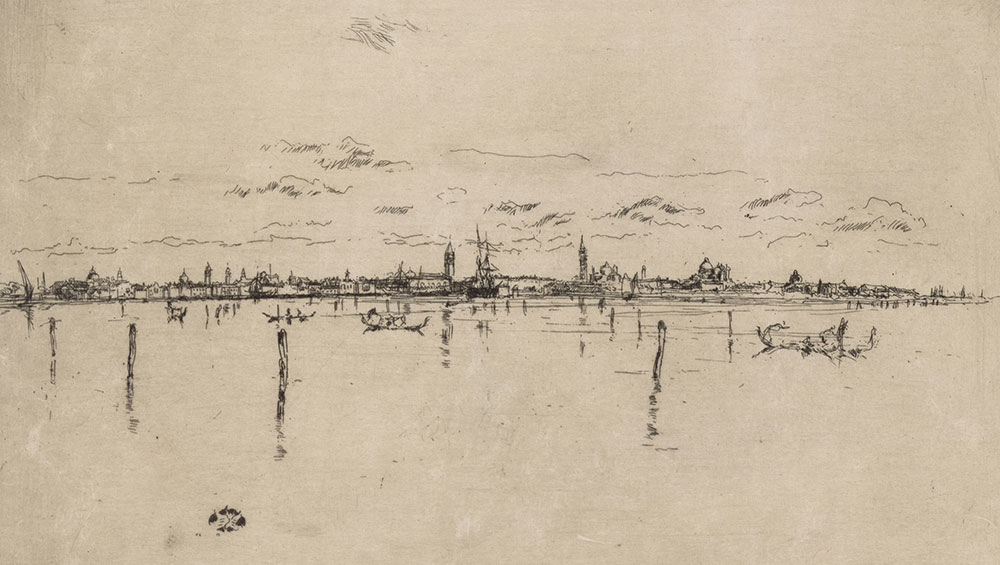
James Abbott McNeill Whistler. The Little Venice, 1879–80. Etching and drypoint, sheet: 7 3/8 × 10 9/16 in (18.7 × 26.8 cm). © Staatliche Museen zu Berlin, Museum of Prints and Drawings / Wolfram Büttner.
Kupferstichkabinett, Berlin
25 September 2024 – 12 January 2025
by SABINE SCHERECK
Pretty pastel colours are a key feature of French impressionism as epitomised by Claude Monet’s Water Lilies series (1897-1926) or his Sunrise (1872), which is now celebrated as the beginning of impressionism, the main pursuit of which was to capture the shimmering effects of light. But impressionism did not only include oil colours on large canvases. Even before Monet’s landmark depiction of the red sun over the port of Le Havre, Johan Barthold Jongkind created Setting Sun over Antwerp Harbour (1868), an etching that Monet would have seen, as the artists knew one another and Monet was influenced by him.
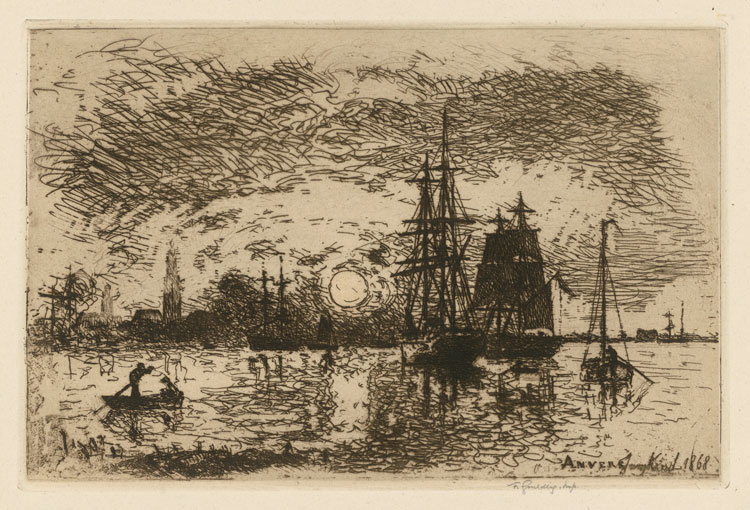
Johan Barthold Jongkind, Setting Sun over Antwerp Harbour, 1868, Etching. © Staatliche Museen zu Berlin, Museum of Prints and Drawings / Dietmar Katz.
The Kupferstichkabinett (Museum of Prints and Drawings) in Berlin is now, for the first time, going beyond the common perception of impressionism, unearthing a trove of print works that showcase the atmospheric moods produced by light – in nature, in cities and in the home. A Different Impressionism – International Printmaking from Manet to Whistler brings together 110 works by 40 artists from six countries. Drawn from the museum’s collection, it not only enables visitors to discover an intriguing array of strong images but also the numerous printing techniques applied, including with colour. The inspiration behind this exhibition springs from the history of the museum. It is part of the Berlin museums, which in 1881 introduced international modernism to the city with the exhibition Painter Etchings by French and English Artists of the Modern Era, which presented 740 prints. It was a daring act at the time because impressionists were not seen as museum-worthy. Yet the public took to the work, which gave a new impetus to contemporary German artists. It also led to a focus on collecting modern prints at the Berlin Kupferstichkabinett: 300 works by English artists were acquired right away. Some of the images, which were shown here almost 150 years ago, can now be rediscovered – a mark on the label highlights them.
Mounted in one room, the exhibition unfolds over seven sections. Considering that it has always been part of the arts to reflect the impressions an artist had of the world, the term impressionism here is not confined to the period of the artistic movement that was burgeoning in France in the late-19th century. In 17th century Holland, Rembrandt van Rijn had already produced etchings exploring the impact of light. Later, early practitioners of photography, which gained momentum at the same time as impressionism, were also driven by capturing light, and even sought to emulate prints or paintings.
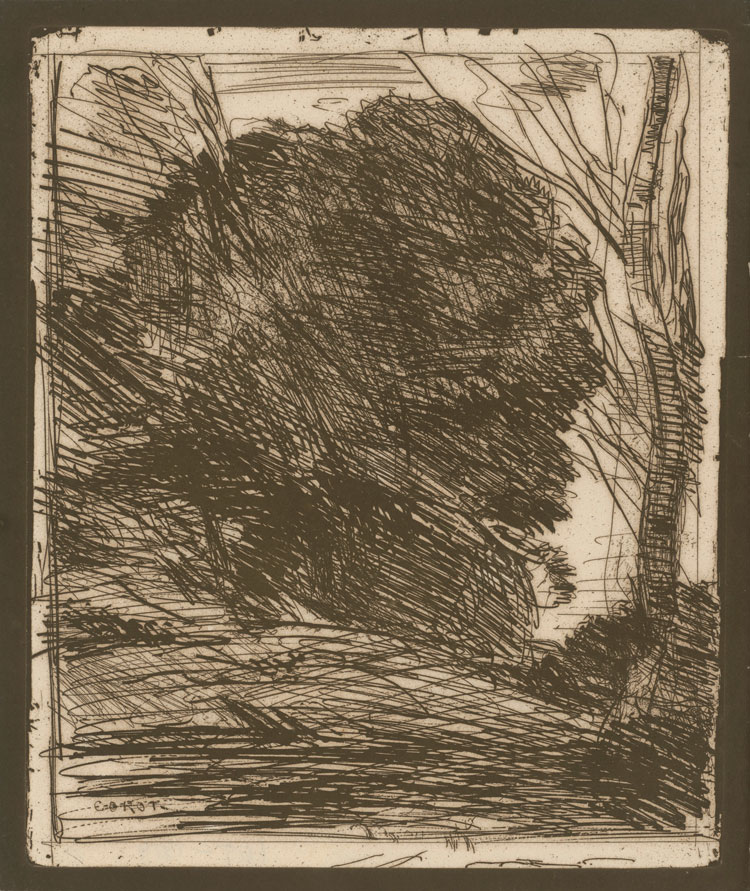
Camille Corot, Bäume am Berg, 1856. © Staatliche Museen zu Berlin, Museum of Prints and Drawings / Dietmar Katz.
Hence, curator Anna Marie Pfäfflin’s first stop on the path leading the visitor through the print world are works employing cliché-verre, a technique that many people will not have heard of. Artists including Camille Corot and Charles-François Daubigny took a glass plate coated with a lightfast layer, incised a drawing with an etching needle, and then put the glass on to light-sensitive paper. The results look like etchings but could equally be regarded as photographs created without a camera. Among the samples here are Daubigny’s A Cluster of Alders (1862) and Night Effect (1862). Both show a waterfront with trees, reeds and boats. The latter depicts a setting sun at the edge of the horizon with reflections on the water, and though quite dark, it has a peaceful feel.
For many painters of the period, etchings were part of their portfolio to ensure their work reached a greater audience by distributing it through print. The French publisher Alfred Cadart was instrumental in encouraging painters to experiment with it. This was a win-win situation as artists also created original work, not just copies of existing works, and Cadart had something special to offer his readership. He was particularly interested in the aquatint technique, where the etching produces areas of tone rather than lines. Camille Pissarro combines aquatint with etching in Forest Path in Pontoise (1879). Like the waterfront with its play of light, the woods were equally popular with impressionists keen to catch the glittering effects of the sun. Here, the etched flat areas make it look rather experimental, with various shades of grey.
A very different style and setting mark Edgar Degas’ pictures, which are set indoors. One is The Painter Mary Cassatt at the Louvre (c1879/80), also an aquatint but combined with drypoint. It has a certain softness to it, but stands out because its ironic rendition of the scene. The American impressionist painter Cassatt and Degas were close friends, so this image is also an affectionate gesture. It shows Cassatt from behind leaning on her folded umbrella while contemplating a painting in front of her of a man and a woman seated on a divan. Cassatt’s slightly tilted head betrays a somehow sceptical, questioning view of the image. The idea of being puzzled by it is underlined by another woman, seated on a bench to her left and consulting a booklet while looking at that same painting. The scene, has a condescending, if humorous, undertone, giving the impression that women would have no understanding of art. However, the fact that women were perfectly able to excel in the arts, in this case the performing arts, is shown in Degas’ black-and-white lithography Mademoiselle Bécat at the Café des Ambassadeurs (1875). It is dominated by the darkness of the auditorium and accentuated by various lamps, including a chandelier in the top left corner under which Mademoiselle Bécat takes a bow. She is lit by footlights, which cannot be seen. Admittedly, this picture might not be regarded as a classic example of impressionism, but it does demonstrate the way light determines what we see in a photograph.
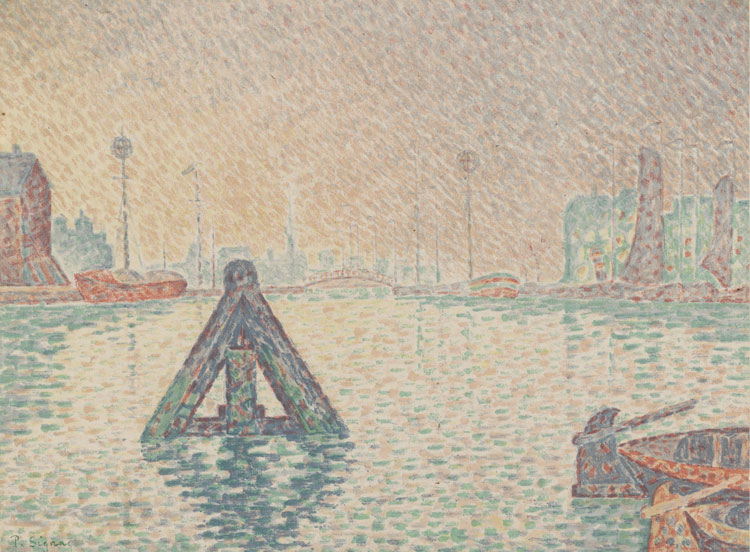
Paul Signac, In Holland – The Beacon, 1894. Colour lithograph. © Staatliche Museen zu Berlin, Museum of Prints and Drawings / Dietmar Katz.
Nearby Degas, but far away in style, a different print world opens up, with colour lithographs by Paul Signac, in which he employs his signature style pointillism. Evening (1898) shows a port at sunset with a sky tinted in a soft yellow gradually turning into apricot, pink and purple, which is reflected on the water. The colour spread serves as background and you can see how the picture is composed of the different print layers with boats, a quay and the ripples of water, which gives it a particular charm.
From the French renaissance of the art of etching, we cross the channel to Britain and then the Atlantic to New York. In Francis Seymour Haden’s panoramic view of Erith Marshes (1865), water and sky again take up most of the space, which is almost all in white in strong contrast to the tiny boats in black and a long thin stretch on the horizon with trees and land. The American artist James Abbott McNeill Whistler captures a more ephemeral scene by the waterfront in a lithograph called Early Morning (1878): this time, it is a port although the city is not revealed. The atmosphere is striking and the tones and outlines so soft that it could easily be a watercolour. Also striking because of its lightness is his view of Venice in Little Venice, the first Venice series, plate 1 (of 12) (1879/1880).
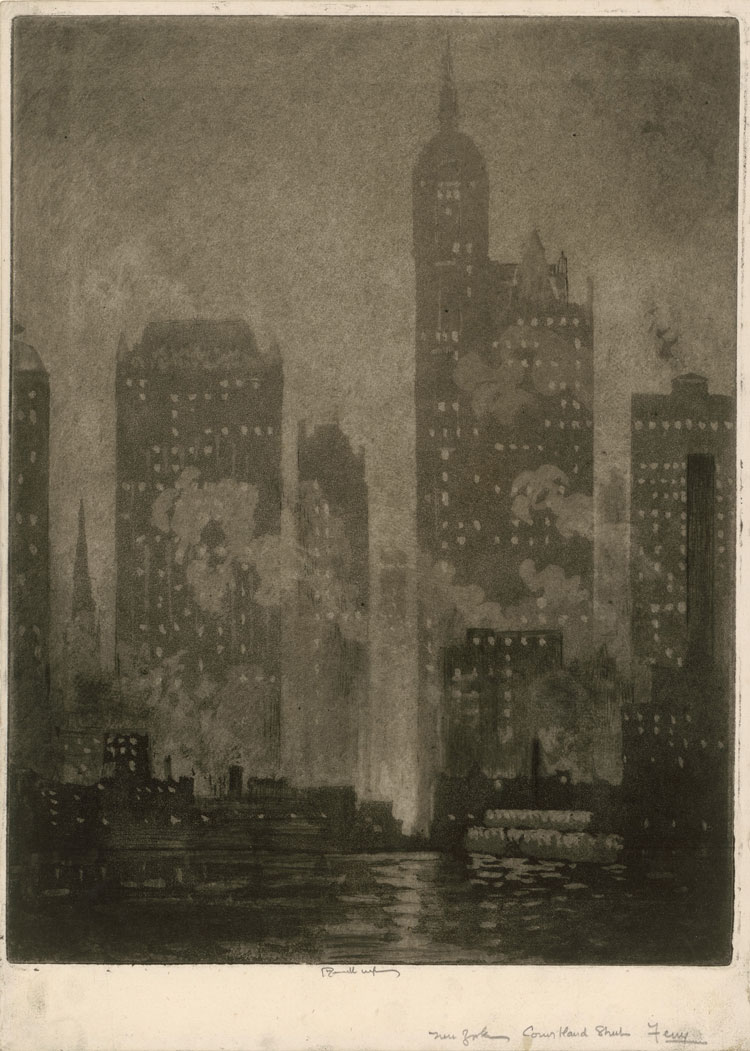
Joseph Pennell, From the Cortlandt Street Ferry, 1908. Sandpaper ground, aquatint and etching. © Staatliche Museen zu Berlin, Museum of Prints and Drawings / Dietmar Katz.
The biggest discovery is Joseph Pennell, also an American, who had relocated to London and learned from Whistler. He took up the urban theme and his etching Charing Cross Shops at Night (1903) plunges the viewer right into autumn when the light coming from the shops almost dances as it is reflected on the wet asphalt. The street is busy with small figures under umbrellas rushing by. Despite the dismal weather and the overall darkness, the illuminated shop windows give it a cosy feel. The view is from a higher vantage point, so a scene Pennell might have caught looking out of the window. In contrast to most other artists presented here, Pennell was not a painter but an etcher, lithographer and illustrator by trade. His mastery is visible, too, in his depictions of New York in densely atmospheric aquatint and dry point. In Courtland Street Ferry (1908) silhouettes of skyscrapers rise in soft tones against a dark, cloudy sky. Only a small gentle light emerges low down in the gap between the tall buildings. A river and billowing steam in the foreground give an intriguing depth to the whole, despite the flat shapes of the individual components.

Frank Brangwyn, St. Nicholas Church in Furnes, 1908. Etching, aquatint and drypoint. © Staatliche Museen zu Berlin, Museum of Prints and Drawings / Dietmar Katz.
Also at this time, the Bruges-born Welsh artist Frank Brangwyn was taking the art of etching to a different level, enlarging the format to more than 50cm x 60cm, for example, in Church of St Nicholas, Diksmuide (1908). Equally impressive but slightly smaller is his Church of St Nicholas in Veurne (1908). Both combine etching, aquatint and drypoint, and demonstrate his skilful representation of monumental architecture and the way the sun illuminates the buildings.
The final section of the exhibition traces the many ways in which these etchings inspired German artists, particularly when it came to integrating colour into their work. Walter Zeising’s Frauenkirche in Dresden by Night (c1890/1900) attracts much attention. Partly this is because of its large size, 61cm x45cm, and partly because of its vast dark blue sky opening up behind the soft silhouette of cathedral and the street to its left illuminated by small glowing street lamps, which from a distance look like fairylights, giving the scene a romantic touch.
There are also smaller jewels, such as Henriette Hahn-Brinckmann’s Outer Alster (1897), set in Hamburg by the Alster river, which has an airy quality. The colour woodcut enchants with its simple composition and colour scheme of soft blues and purples with some green for the trees. The calm water evokes a peaceful morning when the city’s skyline emerges out of the mist in the distance.
In stark contrast is Franz Skarbina’s Hackney Carriage in the Rain (1896). It is a colour lithography, but black and grey tones dominate the night-time scene, interspersed by tiny streetlights. Remarkable, however, is its realism in the way the light is reflected on the cobblestones and the speed with which the carriage crosses the street towards the right. None of the horse’s hooves touch the ground. This snapshot style of the image, almost like a photograph, gives the work immediacy.
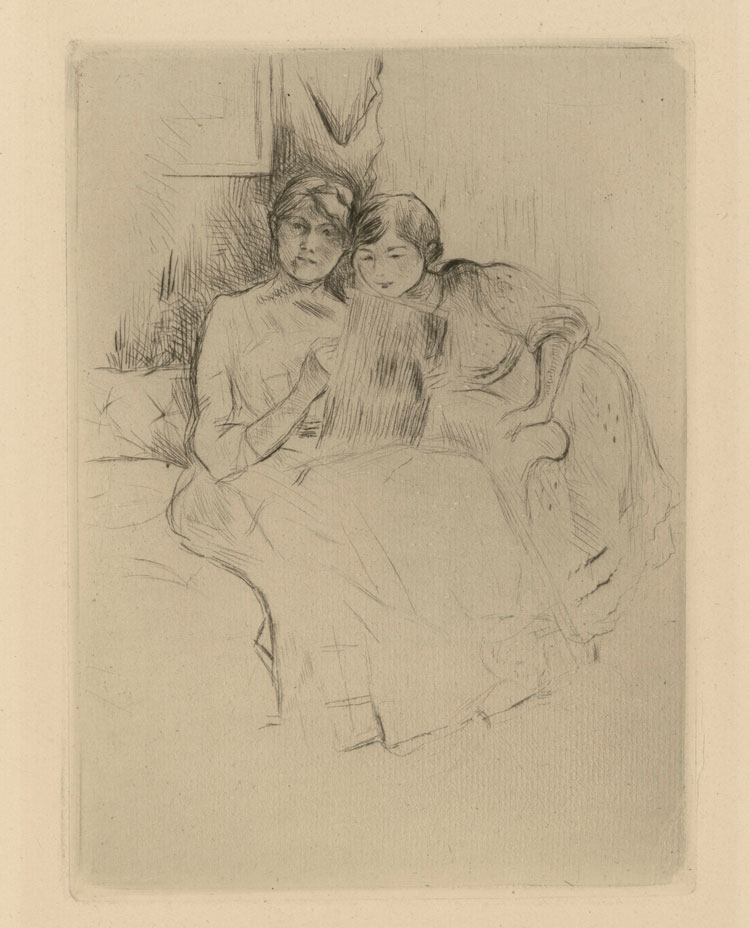
Berthe Morisot, Berthe Morisot drawing with her daughter, 1889. Drypoint. © Staatliche Museen zu Berlin, Museum of Prints and Drawings / Dietmar Katz.
There are many fascinating works in this exhibition, which brings together an impressive list of acclaimed artists. Besides those already mentioned are Édouard Manet, Berthe Morisot, Auguste Renoir, Anders Zorn, Lesser Ury, Lovis Corinth, Max Liebermann and Max Slevogt. In addition to the much-featured landscape in the images, there are also numerous portraits.
This exhibition is like a rollercoaster ride through a world that rarely gets such attention in the art scene, but it is a very rewarding one.